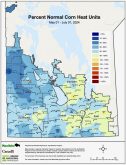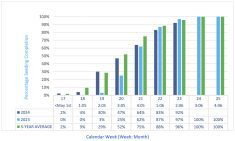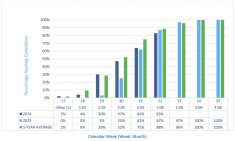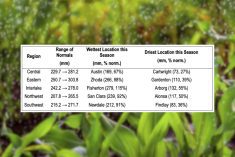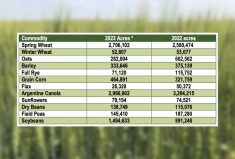Overview
Limited harvesting of fall rye and winter wheat began late last week. Winter cereal crops continued to dry down with producers applying pre-harvest herbicides or swathing as crop seed moisture content allowed. Harvest is expected to become more general this week if the weather cooperates. Crop condition remained good to excellent. Early yield reports are from 60 to 70 bushels per acre on open pollinated fall rye to upwards of 80 to 90 bushels per acre on hybrid fall rye.
Most spring cereal crops were in the intermediate to hard dough stage with the exception of very late seeded crops that were in early dough. Application of pre-harvest herbicides could begin at the end of this week on some early seeded fields if weather allows.
Read Also

Manitoba boosts stake in cereals centre to $23.5 million
Premier Wab Kinew said the additional project funds will help ‘Trump-proof’ the provincial economy.
Most of the canola crop ranged from flowering about 80 per cent complete to mid pod fill. Overall crop condition ranged from fair to mostly good. Later seeded canola crops are in full flower with the early seeded crops going out of bloom and podding. Crop is also showing drought stress, as areas in fields are starting to show flowers aborting.
Reports of waterhemp showing up in soybean fields in the RM of Emerson-Franklin and in the RM of DeSalaberry. Producers are encouraged to scout for this weed and remove from fields when found. For more information please see link to the Manitoba Crop Pest Update July 19 edition.
Cereals
Limited harvesting of fall rye began late last week. Harvest is expected to become more general this week if the weather cooperates. Crop condition remained good to excellent. Early yield reports are from 60 to 70 bushels per acre on open pollinated fall rye to upwards of 80 to 90 bushels per acre on hybrid fall rye.
Most spring cereal crops were in the intermediate to hard dough stage with the exception of very late seeded crops that were in early dough. Application of pre-harvest herbicides could begin at the end of this week on some early seeded fields if weather allows.
Corn fields ranged from late R1 (silk) to the R2 (blister) growth stages. The crop remained in good to excellent condition.
The spring wheat crop is rated mostly fair to good (see Table 2 at top).
Oilseeds
Most of the canola crop ranged from 80 per cent flowering to mid pod fill. Overall crop condition ranged from fair to mostly good. Later seeded canola crops are in full flower with the early seeded crops going out of bloom and podding. Crop is also showing drought stress, as areas in fields are starting to show flowers aborting.
Sunflower fields ranged from the R5.2 to R5.9 growth stages with the occasional plant in early R6 being found in some early seeded fields. Some fungicide applications had occurred and others were scheduled for the coming days depending on crop stage and assessment of disease risk. The crop remained in good to excellent condition.
Pulses and Soybeans
Field pea crops growth stage moved rapidly last week with crops ranging from very late R5 to R6. Plants at R7 could be found on some fields, particularly those that received lesser amounts of rainfall. Some early seeded fields are turning and are getting closer to harvest and depending on weather maybe two to three weeks from harvest.
Most soybean fields were at the later R4 (full pod) to R5 (pod fill) growth stages. Overall crop condition remained good on most fields with the exception of some later seeded crop. Fields in the Central region and pushing into the Western regions that have not received a recent rainfall are showing stressed conditions.
Forages and Livestock
Forages
Most dairy producers have either completed or are close to completing second cut. Yields are reported as below average.
Beef producers have largely completed first cut, with some grass and native hay fields remaining. A handful of beef producers have started second cut and greenfeed harvest is ongoing. Hay yields remain highly variable and are dependent on moisture conditions, whereas greenfeed yields are better than expected.
In the Southwest region second cut does not look good and in most areas there will probably not be a second cut unless rain occurs. Many of the hayfields and some pastures are going dormant. Pastures are average to below average condition and are in need of moisture. Producers in some areas have been spraying pastures for grasshoppers.
Reports of high numbers of grasshoppers in pastures and hay fields.
With very little regrowth on second cut hay fields, beef producers need to be mindful of August 15th
approaching, the beginning of the critical harvest fall period. (Link: critical harvest fall period for alfalfa ). No substantial acres of second cut will be harvested in the near future in the Northwest region.
Livestock
Grass conditions on pasture are deteriorating quickly and in some areas grasshoppers are becoming a problem.
Fly pressure has also been reported to be an issue.
Pastures is the Southwest are average to below average condition and are in need of moisture.
Producers in some areas have been spraying pastures for grasshoppers. Dugouts are about 45 per cent full.
Most dugouts are at sufficient levels in the Central and Interlake regions
In the Northwest regions, native hay harvest is 70 per cent completed with yields rated to below normal to normal. Pasture condition continues to decline with no rainfall received this past week. Dry conditions
combined with forecasted high temperatures this week will further stress forages.
Black flies and horse flies are a nuisance to livestock and producers, and are resulting in pink eye issues.
Pastures that have the appropriate stocking density, or utilizing rotational grazing are the most likely to be keeping up with cattle feed demand. However, even on these farms, regrowth is reduced due to lack of moisture this year. Pockets of producers have begun to supplemental feeding in pastures, especially in the Manitou area.
Regional Comments
Southwest
Another week in the Southwest with no significant moisture and warmer temperatures are starting to show effects on crops in most areas. Several areas have crops that are turning prematurely. Any precipitation would be welcome as most areas in the region remain short for moisture. In some areas rain will help some later seeded crops like soybeans and canola but rain may also start reducing quality in early seeded crops.
Fall rye and winter wheat harvest has begun in some areas and yields look to be average with good quality. Some reports of ergot showing up in fall rye. Reports continue of grasshoppers damaging the crops as they move from dried pastures and hayland into crops.
Pea crops are in R4 to R5 stage. Some early seeded fields are turning and are getting closer to harvest, depending on weather they may be two to three weeks from harvest. Pea crops look to be an average yield with dry conditions effecting development of upper pods.
Wheat crops are in the soft dough stage and the heat is starting to effect overall yield potential. Tillers are starting to dry up and are not fully developing heads. Fusarium head blight seems low this year. We have also received some reports of aphids on wheat heads.
Barley fields are showing effects from the dry conditions and the heat. Several fields have the barley heads stalling in the flag leaf stage. In years when we have seen this happen, it usually means reduced yields and quality (lower bushel weight). Barley yields look to be below average and of lower quality.
Oat crops are in the milk stage and are also showing the effects of the warm dry conditions. Several fields have large white areas showing up and they continue to get larger as the crop runs out of moisture.
Later seeded canola crops are in full flower with the early seeded crops going out of bloom and podding. Crop is showing drought stress as areas in fields are starting to show flowers aborting. No major insect or disease issues showing up. Potential yield looks to be average to slightly below average as pod development does not look as good as previous years.
Soybeans are at R4 stage. Crops look fair and are in need of rain at this point. There is some late weed growth in areas where the stands are thin, especially volunteer canola. Rain is a must in the next week, without rain yield looks to be average at best.
Most corn has silked and tasseled. The crop has managed the dry conditions well, however light sandy soil areas without rainfall are showing severe signs of stress. Overall yield potential will depend on cob development. Without rain, yields will be below average both grain and silage.
Northwest
A mostly warm week across the Northwest region, although night time temperatures continue to dip into the single digits. Ruthenia recorded 1.9 C for a low, while daytime high was Amaranth at 32.7 C. Few locations received precipitation with The Pas receiving the most at 14 mm. The rest of the region would greatly benefit from a rain as soil conditions continue to dry out.
Fall rye and winter wheat continue to mature. Pre-harvest applications are occurring as stages are reached. Harvest of perennial ryegrass has started.
Spring cereals are mostly in the soft dough stage, except for a few later seeded fields which follow closely behind in the milk stage. Moisture stress is observable in some fields. Cereals for the most part are in good to fair condition.
Canola continues in various stages across the region due to the wide range of seeding dates and emergence. Many fields have wrapped up flowering and will continue to maturity now. In the Swan Valley and Roblin area approximately 60-70 per cent of the crops have finished flowering. The Dauphin area is approximately 30 per cent done flowering. Some fields that were short on moisture through the season have short pods.
Field peas are in the R5, while some fields are approaching R6 growth stage. Desiccation of some fields is approaching quickly. Field peas are mostly in good condition except those that did not receive adequate precipitation.
Soybeans are mostly at the R3 stage and quickly approaching R4 across the region. For the most part they look good, but in some areas that haven’t received moisture they appear short. With dry conditions grasshopper pressure continues.
Central
The week was hot and dry for most locations in the central region. Some localized areas did receive rain, with producers around Emerson receiving 40.9mm of rain over the past week, Morris 23.7mm and Altona 15.5mm. Those who received significant rainfall have seen visual improvements on crops. However, most producers in the Central region received very little or no rain this past week. The climatic conditions this year has resulted in crops approaching harvest much earlier than usual. Harvest is well underway for winter cereals. and peas likely to begin harvest this week.
Aphids have been observed in soybean and cereals, with some producers noticing populations well above economic thresholds. Grasshoppers are high in localized areas, feeding on cereals, pasture and some soybean and dry bean fields. In some fields, grasshoppers have all but totally consumed cereal flag leaves.
Producers continue to scout their fields for weeds which have escaped control. This is an important part of integrated pest management. Waterhemp has been found in Manitoba soybean fields again this year and it is very important that producers remove this weed from fields before seed set. For more information please consult the Manitoba Crop Pest Update July 19 edition.
Fall rye and winter wheat are at the hard dough stage and onwards, with many fields already swathed and combined. The remaining winter cereals will be harvested within one to two weeks. Winter cereal yields are down from 2022 due to the drier weather conditions.
Field peas are ripening, with some very close, if not already ready to harvest. Canola is either at the end of flowering (90 – 100 per cent) or undergoing pod fill. Flax is at the end of flowering (95 per cent) with bolls filling rapidly. Soybean and dry beans are flowering with pods forming, between R3 – R5.
Eastern
Last week, most of the rainfall occurred at the start of the reporting period as part of two separate weather events. On Tuesday, most districts received some rainfall ranging from trace amounts to greater than 70 mm. Rainfall mostly occurred as part of fast moving thunderstorms that were the most intense in southern and central districts. This is where the greatest amounts of rainfall occurred accompanied by hail and strong winds. On Wednesday, a downburst with a maximum wind speed of 155 km/h occurred in Beausejour. The town and surrounding area suffered both property and crop damage. Rainfall amounts from this fast moving thunderstorm system ranged from trace to over 50 mm and included hail in some areas with hailstones ranging from 2.5 to 7 cm in diameter. The storm affected an area north of Selkirk through to the Ontario border. Growers in many areas continued to characterize soil moisture levels as just keeping up with crop demand and would welcome more rain over the coming weeks provided it was not part of severe weather.
Limited harvesting of fall rye and winter wheat began late last week. Winter cereal crops continued to dry down with producers applying pre-harvest herbicides or swathing as crop seed moisture content allowed. Harvest is expected to become more general this week if the weather cooperates. Crop condition remained good to excellent.
Most spring cereal crops were in the intermediate to hard dough stage with the exception of very late seeded crops that were in early dough. Application of pre-harvest herbicides could begin at the end of this week on some early seeded fields if weather allows. Crops continued to show greater amounts of turning and colour change. Overall, cereal crops remain in fair to mostly good condition although some oat fields seeded on light soils and in lower rainfall areas continued to show stress symptoms, most notably turning white and rapidly drying down.
Corn fields ranged from late R1 (silk) to the R2 (blister) growth stages. The crop remained in good to excellent condition. Disease and insect scouting continued although no concerns were identified thus far.
Sunflower fields ranged from the R5.2 to R5.9 growth stages with the occasional plant in early R6 being found in some early seeded fields. Some fungicide applications had occurred and others were scheduled for the coming days depending on crop stage and assessment of disease risk. The crop remained in good to excellent condition. Scouting for insects continued and some insecticide applications to control banded sunflower moth had occurred.
Most of the canola crop in the region ranged from flowering about 80% complete to mid pod fill. Overall crop condition ranged from fair to mostly good. Insect scouting continued and some insecticide application to control diamond back moth larvae and lygus bugs had occurred.
Overall, flax crops growth stages ranged from 9 (late flower) to 10 (green capsule). The crop was mostly in good condition overall but, in drier areas, some crops in fair condition could be found.
Most soybean fields were at the later R4 (full pod) to R5 (pod fill) growth stages. Overall crop condition remained good on most fields with the exception of some later seeded crop. Insect scouting continued, particularly for soybean aphids, and the appearance of soybean aphid predators was noted. On some fields, increased soybean aphid numbers as compared to last week were found but these populations remained below threshold levels and often in “hotspots” within fields.
Field pea crops growth stage moved rapidly last week with crops ranging from very late R5 to R6. Plants at R7 could be found on some fields, particularly those that received lesser amounts of rainfall. On such fields, crop desiccation was expected to occur later this week. The majority of the crop remained in good condition but, in drier areas, fields in fair condition and demonstrating lower yield potential were noted.
Interlake
The Interlake region continues to experience warmer weather conditions, with daytime temperatures up to 30 to 33 C; daily averages around 20 C. Spotty rainfall for most of the region, although higher amounts may have dropped with thundershowers in the North Interlake area. Some parts of the Interlake region had minimum to moderate hail damage. Growers reported hail damage in the Fisher Branch and Selkirk area in corn, canola, and wheat fields.
Overall crops are above average and look excellent with recent showers. All cereals have rapidly advanced, with the heat and drier conditions; premature ripening is evident in the driest areas. A few winter cereal fields have been harvested, particularly fall rye. These fields had above average yields with early estimates of 100 bushels/acre. Winter wheat has been desiccated with harvest starting next week. Spring wheat begins to dry down and harvest is expected in the next ten to fourteen days.
Most soybeans have advanced to the R3 – R4 stage. Majority of fields are looking good regardless of rain, but will need ongoing rains to fully fill out. Peas are close for desiccation and harvest should begin in the next seven to ten days.
Insect pressure is low in the South Interlake. Grasshoppers continue to be monitored, some headlands and whole fields have received insecticide applications. Concern has been mostly in pastures, cereal, forage grass fields, canola and corn, and pressure is higher in the North. Some canola fields have been sprayed for diamondback moth. Army worm counts are higher in the South Interlake. Growers in the Stonewall area are starting to see diamondback moth in canola, and aphids are making an appearance in their wheat fields. Monitoring will continue for diamondback moth and bertha armyworm larvae. Some aphids were reported in soybeans, producers are encouraged to continue monitoring through the R3 to R5 growth stages.



